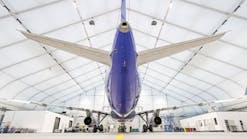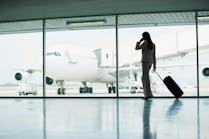On Jan. 23, more than 15,000 flights departed from or landed in China. Three weeks later, that number plummeted to less than 2,500. Prior to the outbreak and spread of the Coronavirus, Statista estimated that global airline revenues would approach $580 billion in 2020. But now, after international borders were closed and domestic travel was drastically reduced, the airline industry stands to lose more than $300 billion this year.
But there are positive signs on the horizon.
In May 2020, U.S. airlines carried 8.4 million passengers, according to the Bureau of Transportation Statistics. Sure, that was down $79 million from May 2019, but it was an increase of 5 million passengers from the previous month. Air travel has steadily increased since then and, once a vaccine is available, we could see a significant increase in air travel.
While it may take some time for air travel to return to pre-COVID numbers, there is little doubt that with each passing month and more businesses returning to “normal” operations, more and more people will start flying again.
Airports need to be prepared for this inevitability and have no margin for error in how they safely manage passenger movement from the time they arrive at the airport to the time they board the airplane for their destination.
To survive in a Coronavirus-challenged world, airport operators will need to lean on the latest building transportation technologies and systems that empower them to be smarter and safer, as well as a new approach to “clean.”
COVID-19 Protective Measures
First and foremost, airports must apply the latest in equipment sanitation. There are a variety of options that can be implemented, starting with foot-activated elevator buttons. Passengers simply need to press their shoe on the hall or car station button to call an elevator or select their floor and receive a hands-free elevator experience. Beyond the COVID-19 benefit of avoiding a touchpoint, this also adds a convenience for passengers who are often carrying luggage or children and have their hands full. Foot-activated elevator buttons are easily retrofitted into existing elevator systems, ensuring minimal downtime.
Another way to minimize virus transmission risks is to provide cleaner and safer handrails on escalators and moving walks. Handrails are high-risk surfaces for bacteria, and while periodic manual disinfection helps, there are technologies available that can provide even greater protection. For example, there are modules that can be installed on the interior of escalators or moving walks with UV-C wavelengths that continuously eliminate microbes from the handrail surface while it operates. UV-C wavelengths are proven to be effective in penetrating the cells of bacteria and viruses and damaging the DNA or RNA containing their genetic code.
IoT and Predictive Maintenance
While implementing physical enhancements to an airport’s building transportation systems may seem obvious, there is another “hands-free” approach that is less obvious. The importance of digitalization and IoT cannot be overstated in any business, especially the airline industry. IoT can be utilized at airports to streamline security, baggage, building and security operations to improve efficiency, as well as for aircraft maintenance and luggage tracking.
But another area is within an airport’s pedestrian transportation systems, including its elevators, escalators and moving walks. Cloud-based, real-time, predictive maintenance technology on pedestrian transportation systems allows for accurate maintenance planning and scheduling, which in turn ensures maximum uptime. Smart technology can capture all data associated with the elevator’s activity, including movement between floors, distance traveled, as well as frequency of elevator doors opening and closing by floor. It also allows service technicians and airports to proactively identify parts or materials that are wearing and in need of replacement in advance of a potential failure.
In short, smart technology allows airports and service technicians to assess the health of connected elevators and their components. Smart technology also provides instant education and access to an elevator’s history, allowing new technicians to get up to speed quickly, which ultimately leads to expedition of service calls. With fewer breakdowns and faster return to service, there are less risks to pedestrian bottlenecks, offering facility managers flexibility when planning preventive maintenance.
Passenger Boarding Bridges
Beyond elevators, escalators and moving walks, there is another key piece in the transportation puzzle, one that many take for granted – and it involves moving from the gate to the airplane. Passenger boarding bridges (PBBs) play an integral role in the passenger movement process, and one of the challenges in the modern social re-acclimation process will be how to manage the passenger boarding process as employees traditionally have been required to be onsite and in close proximity to travelers.
Not anymore.
Airports around the world can now incorporate the latest technology to remotely connect passengers to and from the airplane and gate. There is advanced technology that combines hardware and software, allowing passenger boarding bridges to be safely controlled by an operator from a remote post. Docking maneuvers are carried out by an operator using the prepositioning system that will automatically place the PBB facing the aircraft door and manually connecting it to the aircraft using the motional controls of the remote post. Undocking maneuvers are carried out using the unique fully automatic undocking function.
While airlines and airports are uncertain when the crowds will return, there is one certainty: they better be prepared when they do. Air travel has changed, as have the needs of passengers. Safety is more important than ever and incorporating the latest physical and digital advancements for their respective building transportation systems must be a priority for all airports to ensure a speedier return to normalcy and the total safety of the passengers counting on them.
Jon Clarine is the Head of Digital Services at thyssenkrupp Elevator North America. He is responsbile for the organization’s digitalization strategy and has played a prominent role in its COVID-19 response efforts to help buildings return to work. Beyond vertical transportation, Jon has led digital service and business development in multiple spaces, including: power generation, oil and gas and building management. Jon is a certifed Six Sigma Master Black Belt and holds a Bachelor of Science degree in marine engineering from the United States Merchant Marine Academy and an MBA from the University of South Carolina’s Moore School of Business. Jon lives in Atlanta, Georgia with his wife and two children.







